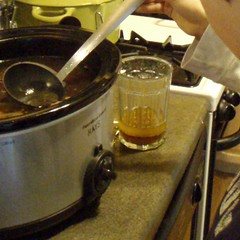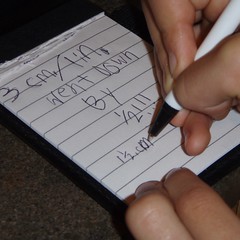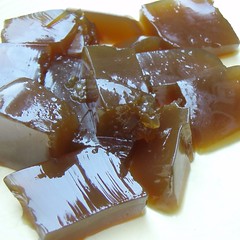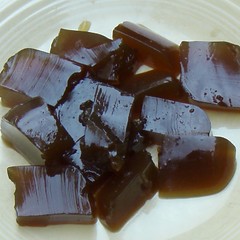Sparky: "What's so special about distilled water?"
I: "Well, it's closer to pure water than tap water. Since it's distilled, many of the things dissolved in regular water aren't there."
Sparky: "What's 'distilled'?"
I: "Well, you know about the water cycle*, don't you? If you boil water, it turns into water vapor. When the water vapor condenses, if you collect it you've got distilled water."
Sparky: "How'd they do that?"
I: "Well, there are huge contraptions called stills that people use to condense vapors into liquids. Most often, they use those to make concentrated alcohol drinks, but you can use them for water, too."
Sparky was definitely curious about this discussion, so I went on to mention that chefs use evaporation in a different way: to concentrate a solution (or, more typically, a sauce.) So we decided to explore the water cycle by making the mother of all mother sauces: Demi-Glace.
While the original Escoffier version of Demi-Glace involves a roux, what many chefs use these days, and what I intended to use to illustrate concentration was simply a reduction of a nice brown veal stock (so, technically we're making Glace de Viande.) Fortunately, stock-making is simple: brown bones and aromatic vegetables, add wine (or another acidic ingredient) and water, cook for a really long time.
 So, Sparky added veal rib bones and a nice marrow bone to my very favorite cooking vessel, which is perfect for this purpose. We then added 3 whole cloves of garlic, two quartered onions, and a large double-handful of carrot pieces (some recipes recommend adding these at the end of the roasting step - I just picked off the burnt bits and we did fine.) We put the whole thing in a 350 degree oven for about an hour, checking it every 20 minutes or so, until we had nice brown drippings on the bottom of the pan and everything was beautifully caramelized.
So, Sparky added veal rib bones and a nice marrow bone to my very favorite cooking vessel, which is perfect for this purpose. We then added 3 whole cloves of garlic, two quartered onions, and a large double-handful of carrot pieces (some recipes recommend adding these at the end of the roasting step - I just picked off the burnt bits and we did fine.) We put the whole thing in a 350 degree oven for about an hour, checking it every 20 minutes or so, until we had nice brown drippings on the bottom of the pan and everything was beautifully caramelized.
Then we transferred all the solids to a large slow cooker, deglazed the pan with 2 cups of red wine, and poured that into the slow cooker along with enough water to cover all the solids. This was left on low overnight.
 In the morning, Sparky skimmed off the fat into a glass cup. After placing a strainer (we like to use a "gold" coffee filter) in the now-cleaned Everything pan, Sparky first got the bit of stock that had settled to the bottom of the fat with a turkey baster. The remaining stock was carefully strained into the pan, and the pan was put on high heat.
In the morning, Sparky skimmed off the fat into a glass cup. After placing a strainer (we like to use a "gold" coffee filter) in the now-cleaned Everything pan, Sparky first got the bit of stock that had settled to the bottom of the fat with a turkey baster. The remaining stock was carefully strained into the pan, and the pan was put on high heat.
Sparky used his ruler to measure the depth of the stock at the center of the pan (3cm.) We allowed it to simmer (a heavy boil is faster, but can cause unwanted coagulation of proteins) for well over an hour, and he measured again when we thought it had reduced sufficiently - we were right, it had reduced to 1.5cm, or by half.
We allowed it to simmer (a heavy boil is faster, but can cause unwanted coagulation of proteins) for well over an hour, and he measured again when we thought it had reduced sufficiently - we were right, it had reduced to 1.5cm, or by half.  I explained that we had removed about half of the water from the stock, leaving a much thicker and more delicious solution behind.
I explained that we had removed about half of the water from the stock, leaving a much thicker and more delicious solution behind.
We then poured most of the stock into ice-cube trays and froze it for future use. The small amount that remained was refrigerated until it gelled, so we could show you how beautiful a Demi-Glace can be:
* This is infinitely better if you listen to Tim Curry reading it.
While the original Escoffier version of Demi-Glace involves a roux, what many chefs use these days, and what I intended to use to illustrate concentration was simply a reduction of a nice brown veal stock (so, technically we're making Glace de Viande.) Fortunately, stock-making is simple: brown bones and aromatic vegetables, add wine (or another acidic ingredient) and water, cook for a really long time.
 So, Sparky added veal rib bones and a nice marrow bone to my very favorite cooking vessel, which is perfect for this purpose. We then added 3 whole cloves of garlic, two quartered onions, and a large double-handful of carrot pieces (some recipes recommend adding these at the end of the roasting step - I just picked off the burnt bits and we did fine.) We put the whole thing in a 350 degree oven for about an hour, checking it every 20 minutes or so, until we had nice brown drippings on the bottom of the pan and everything was beautifully caramelized.
So, Sparky added veal rib bones and a nice marrow bone to my very favorite cooking vessel, which is perfect for this purpose. We then added 3 whole cloves of garlic, two quartered onions, and a large double-handful of carrot pieces (some recipes recommend adding these at the end of the roasting step - I just picked off the burnt bits and we did fine.) We put the whole thing in a 350 degree oven for about an hour, checking it every 20 minutes or so, until we had nice brown drippings on the bottom of the pan and everything was beautifully caramelized.Then we transferred all the solids to a large slow cooker, deglazed the pan with 2 cups of red wine, and poured that into the slow cooker along with enough water to cover all the solids. This was left on low overnight.
 In the morning, Sparky skimmed off the fat into a glass cup. After placing a strainer (we like to use a "gold" coffee filter) in the now-cleaned Everything pan, Sparky first got the bit of stock that had settled to the bottom of the fat with a turkey baster. The remaining stock was carefully strained into the pan, and the pan was put on high heat.
In the morning, Sparky skimmed off the fat into a glass cup. After placing a strainer (we like to use a "gold" coffee filter) in the now-cleaned Everything pan, Sparky first got the bit of stock that had settled to the bottom of the fat with a turkey baster. The remaining stock was carefully strained into the pan, and the pan was put on high heat.Sparky used his ruler to measure the depth of the stock at the center of the pan (3cm.)
 We allowed it to simmer (a heavy boil is faster, but can cause unwanted coagulation of proteins) for well over an hour, and he measured again when we thought it had reduced sufficiently - we were right, it had reduced to 1.5cm, or by half.
We allowed it to simmer (a heavy boil is faster, but can cause unwanted coagulation of proteins) for well over an hour, and he measured again when we thought it had reduced sufficiently - we were right, it had reduced to 1.5cm, or by half.  I explained that we had removed about half of the water from the stock, leaving a much thicker and more delicious solution behind.
I explained that we had removed about half of the water from the stock, leaving a much thicker and more delicious solution behind.
We then poured most of the stock into ice-cube trays and froze it for future use. The small amount that remained was refrigerated until it gelled, so we could show you how beautiful a Demi-Glace can be:
* This is infinitely better if you listen to Tim Curry reading it.







No comments:
Post a Comment